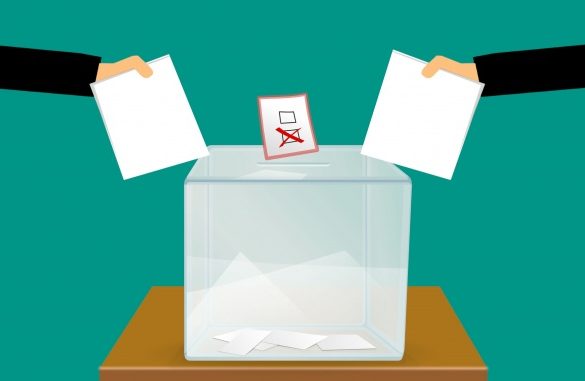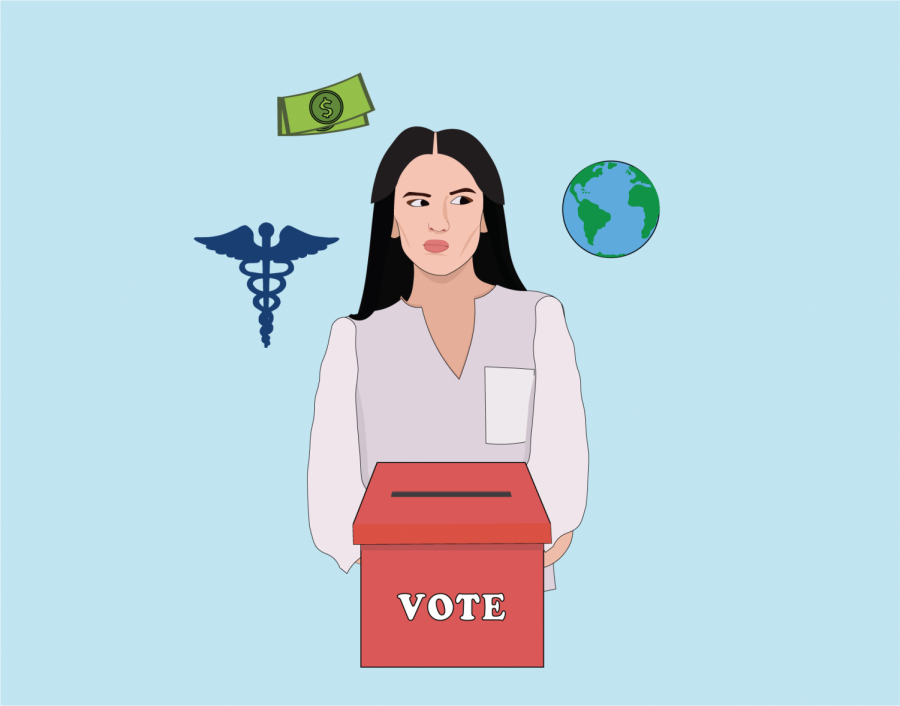What you need to know for Super Tuesday
March 2, 2020
Young Americans should use their power to vote
In March 1965, U.S. troops arrived on the shores of Da Nang, Vietnam, and the antiwar movement across the U.S. erupted in protest.
Youth from across the country gathered with signs plastered with powerful statements, including the well-known phrases “Make Love Not War” and “Hell No! Don’t Go!” As more and more unwilling men were drafted to Vietnam, anger only grew, and an important question was raised: how can we be old enough to be drafted, but not old enough to vote?
Following persistent action from youth across the country, the 26th Amendment was ratified in 1971, lowering the voting age to 18 and prohibiting states from denying anyone ages 18 or older the right to vote. The hope was for the passionate, protesting youth of America to take their energetic desire to enact change to the ballot box.
However, despite continuously maintaining a dominating presence in advocacy, voter turnout amongst young people has been disappointingly low. American democracy is far from perfect, but the enduring emphasis placed on the “power of the people” is what makes the system both admirable and unique. But such “power of the people” cannot exist if the people themselves do not actively participate.
To clarify, the term “young people” refers to eligible voters between the ages of 18 and 24. According to the U.S. Census Bureau, only 40% of voters within this age demographic voted in 2016, compared with senior citizens (65 years or older), who had a 70% turnout; those 45 to 64 years old, who had a 66% participation, and 30 to 44-year-olds, who had a participation rate of 58%. Across the board, young voters lag behind pretty much every other age group by a significant percent, and the 2016 participation rate left millions of young Americans without a red, white and blue “I Voted” sticker.
So what’s the problem?
The first big difficulty explaining low youth turnout is a lack of information. Many people feel that if they don’t know their candidates they shouldn’t vote. For example, Haven Insights finds that 63% of voters reported not knowing who the representative of their district was.
While staying informed can appear daunting, there are many accessible resources available to help you. For example, you can access www.house.gov and type in your zip code for more information. By knowing who is on your ballot, you can make more informed decisions, with more confidence.
Another key way to stay informed is to regularly read credible news outlets. Staying informed will allow you as a voter to determine what is important to you and will empower you to act on that.
It is easy in a politically charged environment to develop what is referred to by PEW Research as “news fatigue,” in which the overwhelming amount of “toxic” political content leaves the reader overwhelmed. But the solution should not be to force out all the information.
There is a misconception that politics doesn’t affect everyone’s lives, and therefore, we should not stay continuously informed. However, while national politics may seem irrelevant to us, local politics definitely transform daily aspects of our lives. The rules for our schools, our community’s development and city budgets are all determined by local politicians. And for people who do care about national and international politics, local politicians have a say in that as well, as they partake in the federal system as a whole. On a daily basis, we are affected by the decisions we make in the political sphere. The cost of every item we purchase, the quality of our education, roads and water are just a few examples.
Despite being as large of a population as Baby Boomers, young voters, as the data shows, have recently turned out at considerably lower rates to the ballot. We have persistently complained about outdated aspects of the system, but it may be that our current situation exists because we have chosen not to act. We have the opportunity to change our world. The question now is: Will we?

Mehek joined the Tribune to grow as a writer and put a spotlight on important things happening around the world. This will be her second and last year with journalism. She joined in her junior year. Her goal...

Elaine joined the Tribune to learn more communication and creative skills. She has been in Journalism for two years as an arts and graphics editor. Most of all, Elaine hates bugs.
Prioritizing electability in politics eviscerates democracy
Going into the 2020 elections, voters should consider policy positions on issues such as healthcare, the environment and the economy, rather than “electability.”
According to a Gallup poll from November 2019, 60% of Democrats surveyed prioritized a candidate with the best chance to beat the incumbent Donald Trump, even if the candidate differs from them on many major issues. This concept of “electability” is not new to politics. But with Democrats anxious to replace Donald Trump in the 2020 election, this preference for electability has become particularly pronounced.
However, while voting for a candidate who can defeat Donald Trump seems like a sound strategy, a deeper look suggests that compromising one’s political beliefs for electability is counterproductive, inadvertently disenfranchising minority, female and progressive candidates.
Michael G. Miller, a researcher from Barnard College, conducted a survey of state elections and found that across party lines, party officials were more likely to question the electability of black and Latino candidates. Importantly, these party officials are generally responsible for finding and encouraging potential candidates to run for office in the first place.
Percy Bacon Jr., a researcher from the polling organization FiveThirtyEight, explains, “Because the U.S. is majority white, and because a significant number of Americans have some negative views about nonwhite people and women, a heavy emphasis on electability can be tantamount to [dis]couraging any candidates who aren’t Christian white men.”
A clear example lies in predictive polling concerning the only top-tier female candidate still in the running: Elizabeth Warren. Polling of over 1,800 registered voters by Avalanche Strategies found that while Warren did not lead in a regular vote, when voters were asked to disregard electability, Warren’s support increased dramatically. She became the leading candidate by a slim margin. Of the voters who switched, 19% specifically cited gender as the main barrier to perceived electability.
Avalanche Strategies concludes, “The pervasive belief isn’t that female candidates are doing anything wrong — but that even if they do everything right, Americans won’t elect a woman … Voters may not need to be convinced that female a candidate is more capable — they must be convinced that Americans are capable of electing them.”
However, the perception that it is more difficult for minorities and women to gain broad public appeal is false. The Roper Center found in 2016 that “the vast majority of Americans now say they would vote for a female candidate.”
Thus, the false perception that women and minorities are less electable than white men creates a positive feedback loop: it dissuades female and minority candidates from running, and the lack of such candidates furthers the perception that they cannot be elected.
Bacon concludes that electability can end up “being used as an all-purpose cudgel against female and minority candidates.”
Luckily, the root of this issue lies in a place where ordinary Americans can make a change: trust.
A Pew Research Center study published in July 2019 finds that only 43% of Americans trusted others to make informed decisions in elections. And a 2019 Ipsos poll found that while 74% of voters were “comfortable” with a female candidate, only one-third thought that their neighbors felt the same way.
A lack of trust in others to make sound choices prompts Americans to prioritize voting for a perceived winner over a candidate they would actually like to see in office. Consequently, Americans with skewed perceptions of how the wider populace views minority and female candidates prefer the “safer” bet of a moderate white male.
This suggests that minority or female candidates like Elizabeth Warren or Andrew Yang (who is no longer in the race) are not necessarily less electable than white male candidates like Joe Biden or Bernie Sanders. Rather, American perceptions of electability create a self-fulfilling prophecy, dooming diverse campaigns before they even begin.
Beyond candidates of racial or gender minorities, many people also vote based on the electability of a candidate’s policies. Usually, this entails voting for moderates that can “reach across the aisle” and appeal to the other party’s voters. It’s why many Democrats back someone like Biden even if they align with more progressive beliefs; they vote out of fear that progressive candidates can’t win in Republican states.
However, empirically, running further to the left has been precisely what flips historically red districts. For instance, Lee Carter, a Democratic Socialist that wasn’t even backed by Virginia’s Democratic Party, ran for the Virginia State House in 2018. His district had voted Republican in every election since 1983. Yet, instead of running on centrist policies, Carter ran on Medicare for All and campaign finance reform. Despite being constantly attacked as a “communist” by his opponents, Carter won the election by a whopping nine points, upsetting a top-ranking Republican in the process.
And this is not an isolated occurrence; an analysis by Lew Blank of The Outsider finds that in 2016, 12 Democrats were elected to the House of Representatives in districts that were pro-Trump. Of those 12, four belong to the Congressional Progressive Caucus — the furthest left faction of the Democratic Party. Blank finds that this success is specifically impressive because most Democrats believe they need to be more moderate to win in Republican areas, which discourages progressives from running, to begin with. Thus, despite their small numbers, progressive candidates were overrepresented in successful flips of red districts.
Evidently, more progressive policies don’t necessarily alienate voters of the opposite party; in fact, they may actually contribute to candidates’ success. And this makes sense because everyday Americans’ lives are getting worse by many metrics: wages are stagnant, the price of healthcare is skyrocketing and income inequality is at a record high. Politics has become dominated by wealthy special interests, and the working class feels abandoned. Candidates who take a middle-of-the-road, status quo approach and who continue catering to the establishment will not inspire any rooted enthusiasm.
Instead, candidates that promote radical change and market themselves as political outsiders will strike a chord with voters who feel disenfranchised by career politicians. This explains why Donald Trump won the 2016 election despite the skepticism of nearly every political pundit, and why going into 2020, a similar approach should be adopted by Democrats to take back the White House.
While beating Donald Trump should undoubtedly be Democrats’ top priority, the approach to doing so should not lie in disavowing progressive, diverse candidates. Rather, Democratic voters should work to empower candidates in whom they truly believe. Only by backing these strong candidates can they become electable in the first place. And only when voters support candidates based on their personal views rather than their (often false) predictions of others’ views can we elect more diverse and representative candidates.
Defendants of electability suggest that it may be beneficial, forcing candidates to maintain a wide appeal over many voters in order to retain their image. This misses the nuance of what the modern view of “electability” is. Being seen as “electable” doesn’t mean appealing to what most Americans want, but rather means appealing to what Americans think most Americans want: white, moderate males. But, as the Roper Center studies suggest, Americans have widened their views of what a presidential candidate can look like.
Thus, as the gap between voters’ perceptions of what Americans want and what Americans actually want widens, the quality of “electability” strays further away from the majority of voters. If anything, rather than promoting the value of far-reaching engagement, it encourages candidates to pigeon-hole themselves into the ideal “electable candidate” mold, dissuading progressive policies and diverse candidates.
While voters who cite electability as a factor likely do so with the positive intention of beating President Trump, recognizing the irony of this strategy can empower Democrats to choose a stronger nominee. Electability should not be disregarded entirely, but voters should not severely compromise their political beliefs to cater to this highly subjective and speculative metric. With sound policies that represent what voters want, a nominee chosen based on merit promises greater conviction and support from Democratic voters. And with this support, electability will follow as well.
The easiest place to start is ourselves. Americans’ trust in one another’s electoral choices is abysmally low, but it is this underestimation of our neighbors that skews our perceptions of what it means to be an “electable candidate.” Thus, those eligible to cast ballots in the upcoming elections should do so with the intent of finding the best candidate, placing faith in fellow Americans to do the same.
If voters make decisions based on candidates’ merits, the definition of an electable candidate will ultimately change as well. Accompanying this change will be greater diversity in our government, both in political ideology and demographics. Thus, expressing your true political beliefs at the ballot box is the best way to correct the distortion of our democracy.

Sanjana joined the Tribune to learn more about her community and have a platform to voice her views. This is her third year in the Tribune and she served as the Co-Opinions Editor last year. For journalism...

Vivian joined the Tribune because she wanted to write about topics she was passionate about and become more knowledgeable about the community and world. This is her second year on the Tribune. One interesting...

Claire joined the Tribune because she was looking to try something new. She decided on joining the school newspaper because it seemed like it would be an interesting activity. Claire has been on the Tribune...

